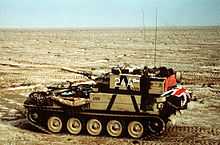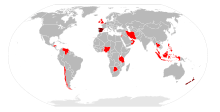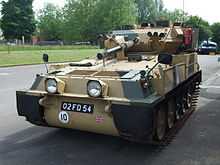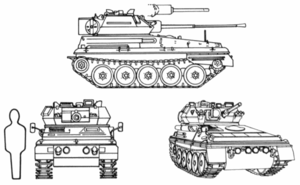FV101 Scorpion
| FV101 Scorpion | |
|---|---|
|
Irish Army Scorpion CVR(T) | |
| Type | Reconnaissance vehicle |
| Place of origin | United Kingdom |
| Service history | |
| In service |
1973– (Retired in 1994 by the UK) |
| Used by | Users |
| Wars |
Iran–Iraq War Falklands war Gulf war |
| Production history | |
| Manufacturer | Alvis Vehicles Ltd, Coventry, England |
| Variants | Scorpion 90 |
| Specifications | |
| Weight | 17,800 lb (8.074 tonnes) |
| Length | 5.288 m (17 ft 4.2 in)[1] |
| Width | 2.134 m (7 ft 0 in)[1] |
| Height | 2.102 m (6 ft 10.8 in)[1] |
| Crew | 3[1] |
|
| |
| Armour | 12.7 mm welded aluminium |
Main armament |
ROF 76mm L23A1 gun 90 mm in Scorpion 90[1] |
Secondary armament | Coaxial 7.62 mm L43A1 machine gun[1] |
| Engine |
Cummins BTA 5.9-litre (diesel)[1] 190 hp (140 kW) |
| Power/weight | 22.92 hp/tonne[1] |
| Transmission | David Brown TN15[1] |
| Suspension | Torsion-bar |
Operational range | 756 km (470 mi)[1] |
| Speed | 72.5 km/h (45.0 mph)[1] |
The FV101 Scorpion is a British armoured reconnaissance vehicle. It was the lead vehicle and the fire support type in the Combat Vehicle Reconnaissance (Tracked), CVR(T), family of seven armoured vehicles. Manufactured by Alvis, it was introduced into service with the British Army in 1973 and served until 1994.[2] More than 3,000 were produced and used as a reconnaissance vehicle or a light tank. It holds the Guinness world record for the fastest production tank; recorded doing 82.23 kph (51 mph) at the QinetiQ vehicle test track, Chertsey, Surrey, on 26 March 2002.[3]
History
The Alvis Scorpion was originally developed to meet a British Army requirement for the Combat Vehicle Reconnaissance (Tracked) or CVR(T). In 1967 Alvis were awarded the contract to produce 30 CVR(T) prototypes. Vehicles P1–P17 being the Scorpion prototypes were delivered on time and within the budget.[4] After extensive hot and cold weather trials in Norway, Australia, Abu Dhabi and Canada, the Scorpion was accepted by the British Army in May 1970, with a contract for 275 which later rose to 313 vehicles.[5] The first production vehicles were completed in 1972 and the first British regiment to be equipped with the Scorpion were the Blues and Royals of the Household Cavalry in 1973.[5][6] In November 1981, the RAF Regiment took delivery of its first of 184 Scorpions and other variants of CVR(T).[7]
Alvis built more than 3,000 Scorpion vehicles for the British Army and Royal Air Force Regiment and the export market.
All the CVR(T) vehicles were to be air-portable and two Scorpions could be carried in a C130 Hercules. Another requirement of the CVR(T) project was the low ground pressure - similar to that of a soldier on foot - and this would serve it well in the boggy conditions of the Falklands War.
Armament
| L23A1 gun | |
|---|---|
| Place of origin | United Kingdom |
| Service history | |
| In service | 1973–present |
| Production history | |
| Manufacturer | Royal Ordnance |
| Specifications | |
| Length | 2.157 m (7 ft 0.9 in) |
|
| |
| Calibre | 76 mm (3.0 in) |
| Rate of fire | 6 rounds per minute |
| Effective firing range | 2,200 m (2,400 yd) |
The Scorpion was armed with the low velocity 76 mm L23A1 gun, which could fire high-explosive, HESH, smoke and canister rounds. Stowage was provided for 40 or 42 rounds. A 7.62 mm coaxial machine gun (3,000 rounds carried) and two multi-barreled smoke grenade dischargers were also fitted each side of the turret.[1] Main armament elevation is 35 degrees and depression of 10 degrees with a full 360 degree traverse.[8]
Engine
The original engine was the Jaguar J60 4.2-litre petrol engine,[9] which was replaced by a Cummins or Perkins diesel engine.[1] The maximum speed was about 50 miles per hour (80 km/h) and it could accelerate from nought to 30 miles per hour (48 km/h) in 16 seconds. The maximum speed on water (with the flotation screen deployed) was 3.6 mph (5.8 km/h).[10]
The Irish engineering company IED replaced the existing Jaguar engine in a successful re-powering process with a Steyr M16 TCA HD engine (6-cylinder, 145 kW), making the Scorpion more powerful and more reliable in critical environment.[11]
Other systems
The vehicle was fitted with a nuclear, biological, chemical protection system, image intensification sights for gunner and driver and a floatation screen.[1] A commode was located under the commander's seat, an internal water tank and a boiling vessel for cooking and heating water were also provided.[12]
Scorpion 90
The Scorpion 90 or Scorpion 2 was a version armed with the long-barrelled Cockerill Mk3 M-A1 90mm gun designed for the export market.[13]
Service history
The Scorpion was or is used by the armed forces of Belgium, Botswana, Brunei, Chile, Honduras, Iran, Indonesia, Ireland, Jordan, Malaysia, New Zealand, Nigeria, Oman, Philippines, Spain, Tanzania, Thailand, Togo, Venezuela and the United Arab Emirates.[1]
While Canada never operated the Scorpion the original Scorpion turret was married with the MOWAG Piranha I chassis to create the AVGP Cougar fire support vehicle used by the Canadian Armed Forces.
The Scorpion on occasion deployed in main UK airports as a measure against possible terrorist threats, e.g., Heathrow Airport in 1974.
Combat use

Two troops from B Squadron, Blues and Royals served in the Falklands War. The CVR(T) were the only armoured vehicles used in action by the British Army during the conflict.[14]
Scorpions also served in the Gulf War. The 1st Queen's Dragoon Guards a reconnaissance regiment had 32 and the close reconnaissance troops of the armoured regiments each had eight.[15] Also used by 1 Squadron RAF Regiment, who were attached to the 1st British Armoured Division
Foreign users
Some small armies such as the Botswana Defence Force and the Irish Army, and notably the larger Philippine Army and Nigerian Army continue to use the Scorpion, in some cases up-armed with the 90mm Cockerill.
Sabre
The Scorpion has been withdrawn from British Army service and the refurbished hulls have been mated with surplus turrets from the FV 721 Fox CVR(W) wheeled reconnaissance vehicle to form a composite vehicle—the Sabre reconnaissance vehicle.[16]
Salamander
A small number of converted Scorpions are in use at British Army Training Unit Suffield in Canada as part of OPFOR. With the main armament barrel replaced with a dummy they represent 125mm gun armed T-80-type vehicles.
Users


- 1500 units.
- 701 units.
- 20 units.
- 60 units.
- 16 units.
- 30 units ; in service with the Chilean Marines Corps.
- 19 units.
- 130 units.
- 90 units.
- 14 units.
- 80 units.
- 26 units.
- 26 units.
- 150 units.
- 120 Units.
- 65 units.
- On service until 2009 on the Spanish Navy, (Infantería de Marina Española). There are a couple of units on static display as of 2011.
- 128 units.
- 40 units.
- 12 units.
- 76 Units.
- 78 Scorpion 90, 4 or 6 FV-104 Samaritan, 2 FV-105 Sultan and 4 FV-106 Sanson.[1]
See also

- Combat Vehicle Reconnaissance (Wheeled)
- Other CVR(T) vehicles
- FV102 Striker anti-tank guided weapon carrier
- FV103 Spartan armoured personnel carrier[17]
- FV104 Samaritan armoured ambulance[17]
- FV105 Sultan command post vehicle[17]
- FV106 Samson armoured recovery vehicle[17]
- FV107 Scimitar armoured reconnaissance vehicle[18]
- Sabre – Scorpion chassis retro-fitted with a turret from the Fox Armoured Reconnaissance Vehicle
- Alvis Stormer – a larger development of the CVR(T) used in the case of the British Army to carry the Starstreak High Velocity Missile system[19] and the Shielder minelaying system.[20]
- AVGP Canadian wheeled armoured vehicle fitted with the turret from a Scorpion.[21]
- Medium Reconnaissance Vehicle (MRV) an Australian M113A1 fitted with the turret from a Scorpion.
- Tosan, Iranian-built development of Scorpions supplied to Iran in the 1970s, carrying a 90mm gun and Toophan ATGW
Notes
- ↑ 1.0 1.1 1.2 1.3 1.4 1.5 1.6 1.7 1.8 1.9 1.10 1.11 1.12 1.13 1.14 1.15 "Scorpion". Jane's Information Group. Retrieved 2009-01-11.
- ↑ http://www.publications.parliament.uk/pa/cm200506/cmhansrd/vo060704/text/60704w0003.htm#06070447001554
|chapter-url=missing title (help). Parliamentary Debates (Hansard). House of Commons. July 4, 2006. col. 912W–913W. - ↑ "Fastest tank". Guinnessworldrecords.com. 2002-03-26. Retrieved 2014-05-31.
- ↑ Foss & Sarson, p. 9
- ↑ 5.0 5.1 Foss & Sarson, p. 10
- ↑ Foss & Sarson, p. 4
- ↑ Foss & Sarson, p. 20
- ↑ Foss & Sarson, p. 14
- ↑ "Christopher Chant A compendium of armaments and military hardware". Books.google.co.uk. Retrieved 2014-05-31.
- ↑ Foss & Sarson, p. 12
- ↑ Application Gallery: Steyr-Motors.com
- ↑ Foss & Sarson, p. 11
- ↑ Foss & Sarson, p. 37
- ↑ Foss & Sarson, p. 21
- ↑ Foss & Sarson, pp. 41–44
- ↑ Foss & Sarson, p. 34
- ↑ 17.0 17.1 17.2 17.3 "Spartan and Other CVR(T) Vehicles". MOD. Retrieved 2010-01-14.
- ↑ "Scimitar Armoured Reconnaissance Vehicle". MOD. Retrieved 2010-01-14.
- ↑ "Starstreak High Velocity Missile Vehicles". MOD. Retrieved 2010-01-14.
- ↑ "Shielder Anti-Tank System". MOD. Retrieved 2010-01-14.
- ↑ "Background – Armoured Vehicle, General Purpose – Cougar DFSV". Canadian American Strategic Review. September 2009. Archived from the original on 2009-10-03.
References
- Foss, Christopher F; Sarson, Peter (1995). Scorpion Reconnaissance Vehicle 1972-94. Osprey Publishing. ISBN 1-85532-390-7.
External links
| Wikimedia Commons has media related to FV101 Scorpion. |
| ||||||||||||||||||||||||||